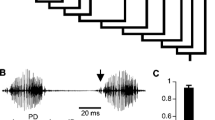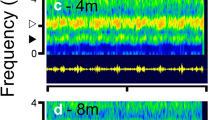Abstract
After being placed equidistant from playbacks of two computer-generated male calls, females of the katydidAmblycorypha parvipennis preferentially moved toward call phrases that were louder, longer, and “leading” (initiated without being overlapped by other call phrase endings). Because earlier tests with calling males had indicated that male mating success was related to these call parameters, we suggest that mating success is partly a result of female choice. Females also preferentially responded to the initial, rather than the latter, half of male phrases. Results of other tests suggested that females were responding to increased phonatome rate characteristic of the first half of the phrase. Males may compete to lead in order to prevent jamming of initial phrase information. Females also preferentially phonoresponded (“ticked”) in response to longer phrases. In earlier studies of male mating success and female phonotaxis using live males, male weight, sound level, and leading were intercorrelated; however, none of these parameters were correlated with phrase length. We suggest that females may respond to different call parameters under different environmental conditions.
Similar content being viewed by others
References
Busnel R. G., and Loher W. (1961). Déclenchement de phonoréponses chezChorthippus brunneus Thunb. (Acridinae).Acoustica 11: 65–70.
Galliart, P. L., and Shaw, K. C. (1991). Role of weight and acoustic parameters, including nature of chorusing, in the mating success of males of the katydid,Amblycorypha parvipennis (Orthoptera: Tettigoniidae).Fla. Entomol. 74: 453–464.
Galliart, P. L., and Shaw, K. C. (1992). The relation of male and female acoustic parameters to female phonotaxis in the katydid,Amblycorypha, parvipennis.J. Orthopt. Res. 1: 110–115.
Galliart, P. L., and Shaw, K. C. (1994). The relationship of weight and sound level to continuity of male calling in the katydid,Amblycorypha parvipennis.J. Orthopt. Res. 2: 43–45.
Gerhardt, H. C. (1991). Female mate choice in treefrogs: Static and dynamic acoustic criteria.Anim. Behav. 42: 615–635.
Greenfield, M. D. (1990). Evolution of acoustic communication in the genusNeoconocephalus: Discontinuous songs, synchrony and interspecific interactions. In Bailey, W. J., and Rentz, D. C. F. (eds.),The Tettigoniidae: Biology Systematics and Evolution, Springer-Verlag, Berlin, pp. 71–97.
Greenfield, M. D. (1994a). Cooperation and conflict in the evolution of signal interactions.Annu. Rev. Ecol. Syst. 25: 97–126.
Greenfield, M. D. (1994b). Synchronous and alternating choruses in insects and anurans: Common mechanisms and diverse functions.Am. Zool. 34: 605–615.
Greenfield, M. D., and Shaw, K. C. (1983). Adaptive significance of chorusing with special reference to the Orthoptera. In Gwynne, D. T., and Morris, G. K. (eds),Orthopteran Mating Systems: Sexual Competition in a Diverse Group of Insects, Westview, Boulder, CO, pp. 1–27.
Gwynne, D. T. (1988). Courtship feeding and the fitness of female katydids (Orthoptera: Tettigoniidae).Evolution 42: 545–555.
Heller, K. G., and von Helversen, D. (1986). Acoustic communication in phaneropterid bushcrickets; Species-specific delay of female stridulatory response and matching male sensory time window.Behav. Ecol Sociobiol. 18: 189–198.
Shaw, K. C., Galliart, P. L., and Smith, B. (1990). The acoustic behavior ofAmblycorypha parvipennis (Orthoptera: Tettigoniidae).Ann. Entomol. Soc. Am. 83: 617–625.
Smith, B. (1986).Acoustic Behavior of Amblycorypha parvipennis in Response to Natural and Artificial Sounds M.S. thesis, Iowa State University, Ames.
Spooner, J. D. (1968). Pair-forming acoustic systems of phaneropterine katydids (Orthoptera: Tettigoniidae).Anim. Behav. 16: 197–212.
Spooner, J. D. (1995). Pair-forming phonotaxic strategies of phaneropterine katydids (Tettigoniidae, Phaneropterinae). InProceedings of the 6th International Meeting of the Orthopterists Society pp. 127–129.
Tuckerman, J. F., Gwynne, J. T., and Morris, G. K. (1992). Reliable acoustic cues for female mate preference in a katydid (Scudderia curvicauda, Orthoptera, Tettigoniidae).Behav. Ecol. 4: 106–113.
Wagner, W. E., Jr., and Sullivan, B. K. (1995). Sexual selection in the Gulf Coast toadBufo valliceps: Female choice based on variable characters.Anim. Behav. 49: 305–319.
Wagner, W. E., Jr., Murray, A., and Cade, W. H. (1995). Phenotypic variation, in the mating preference of female field crickets,Gryllus integer.Anim. Behav. 49: 1269–1281.
West-Eberhard, M. J. (1984). Sexual selection, competitive communication and species-specific signals in insects. In Lewis, T. (ed.),Insect Communication, Academic Press, London, pp. 283–284.
Wyttenback, R. A., and Hoy, R. R. (1993). Demonstration of the precedence effect in an insect.J. Acoust. Soc. Am. 94: 777–784.
Author information
Authors and Affiliations
Rights and permissions
About this article
Cite this article
Galliart, P.L., Shaw, K.C. The effect of variation in parameters of the male calling song of the katydid,Amblycorypha parvipennis (Orthoptera: Tettigoniidae), on female phonotaxis and phonoresponse. J Insect Behav 9, 841–855 (1996). https://doi.org/10.1007/BF02208973
Revised:
Issue Date:
DOI: https://doi.org/10.1007/BF02208973




